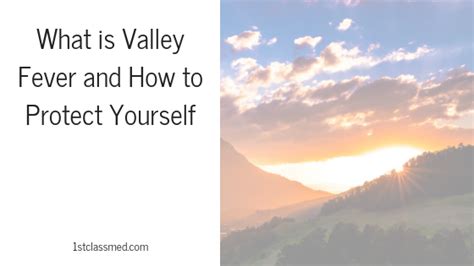As the sun rises over the Golden State, casting a warm glow over California’s vast deserts and fertile valleys, a silent threat lurks in the shadows. Valley Fever, a respiratory disease caused by the Coccidioides fungus, has been a long-standing concern for residents and visitors alike. With its prevalence in the southwestern United States, particularly in California and Arizona, it’s essential to understand the risks and take proactive measures to protect yourself and your loved ones.
To comprehend the severity of Valley Fever, it’s crucial to delve into its history. The disease was first identified in the early 20th century, and since then, it has affected thousands of people, with some cases resulting in severe complications, such as meningitis or pneumonia. According to the California Department of Public Health, the number of reported cases has been increasing over the years, with a significant spike in recent times. In 2020, California reported over 7,000 cases, with the majority coming from the Central Valley and Central Coast regions.
So, what exactly is Valley Fever, and how does it spread? The Coccidioides fungus is typically found in soil and becomes airborne when the soil is disturbed, allowing the spores to be inhaled. This can happen through various activities, such as construction, farming, or even recreational pursuits like hiking or biking. Once inhaled, the spores can cause a range of symptoms, from mild to severe, including fever, cough, fatigue, and chest pain. In some cases, the disease can progress to more serious conditions, such as pneumonia or meningitis, which can be life-threatening if left untreated.
The good news is that there are steps you can take to reduce your risk of contracting Valley Fever. If you’re planning to engage in outdoor activities or work in areas where the fungus is common, wear a mask to minimize inhalation of spores. It’s also essential to avoid disturbing soil whenever possible, especially in areas with high concentrations of the fungus. If you must dig or excavate soil, use water to reduce dust and minimize the release of spores into the air.
In addition to these preventive measures, it’s vital to be aware of the symptoms and seek medical attention immediately if you experience any of the following:
- Fever
- Cough
- Fatigue
- Chest pain
- Shortness of breath
- Headache
Early diagnosis and treatment are critical in managing Valley Fever. If you suspect you’ve been exposed or are experiencing symptoms, consult your healthcare provider for guidance. They may recommend testing, such as a blood test or imaging studies, to confirm the diagnosis and determine the best course of treatment.
While Valley Fever can be a serious concern, it’s not a guarantee that you’ll contract the disease if you live in or visit California. By being informed and taking proactive steps to protect yourself, you can minimize your risk and enjoy all that the Golden State has to offer.
For those who have contracted Valley Fever, it’s essential to understand the treatment options available. In mild cases, the disease may resolve on its own with rest and hydration. However, in more severe cases, antifungal medication may be necessary to manage symptoms and prevent complications. In some instances, hospitalization may be required to provide supportive care and close monitoring.
To further reduce the risk of Valley Fever, several strategies can be employed:
- Wear protective gear: When engaging in outdoor activities or working in areas with high concentrations of the fungus, wear a mask, gloves, and eye protection to minimize exposure.
- Avoid disturbing soil: Refrain from digging or excavating soil, especially in areas with high concentrations of the fungus.
- Use water: When digging or excavating soil, use water to reduce dust and minimize the release of spores into the air.
- Stay informed: Stay up-to-date with local health alerts and advisories, especially during periods of high wind or dust storms.
- Get tested: If you’re experiencing symptoms or have been exposed to the fungus, consult your healthcare provider for guidance on testing and treatment.
In conclusion, while Valley Fever is a serious concern in California, it’s not a reason to avoid the state or its beautiful outdoors. By being aware of the risks, taking proactive measures to protect yourself, and seeking medical attention if symptoms arise, you can minimize your risk and enjoy all that California has to offer.
What are the symptoms of Valley Fever?
+The symptoms of Valley Fever can range from mild to severe and include fever, cough, fatigue, chest pain, shortness of breath, and headache. In some cases, the disease can progress to more serious conditions, such as pneumonia or meningitis.
How is Valley Fever diagnosed?
+Valley Fever is typically diagnosed through a combination of physical examination, medical history, and laboratory tests, such as blood tests or imaging studies.
Can Valley Fever be treated?
+Yes, Valley Fever can be treated with antifungal medication, rest, and hydration. In severe cases, hospitalization may be necessary to provide supportive care and close monitoring.
How can I reduce my risk of contracting Valley Fever?
+To reduce your risk of contracting Valley Fever, wear protective gear, avoid disturbing soil, use water when digging or excavating soil, stay informed about local health alerts, and get tested if you're experiencing symptoms or have been exposed to the fungus.
By understanding the risks and taking proactive measures to protect yourself, you can enjoy the beauty and wonder of California while minimizing your risk of contracting Valley Fever. Remember to stay informed, take precautions, and seek medical attention if symptoms arise. With the right knowledge and precautions, you can breathe easy and enjoy all that the Golden State has to offer.



